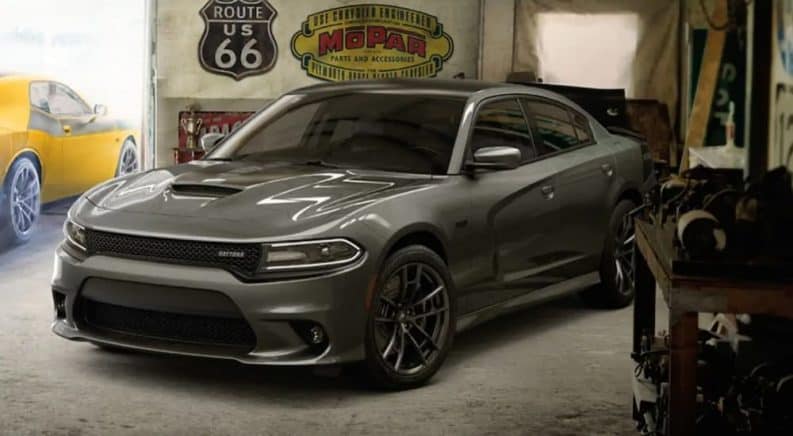As both consumers and the voice of an industry, we’re burdened with a need to remain cognizant of all sorts of statistics and marketing insights. It helps us to understand the inner workings of different types of car buyers, empowering us to anticipate the questions a prospective buyer might need answered, and even curate content around their unspoken needs. And while that sort of thing is perfectly interesting to automotive nerds like us, it introduces certain topics which may not have been scrutinized to the same extent. A great example would be ‘at what point in our development are we most likely to establish brand loyalty to an automaker?’ At least that’s the question that popped into my head as I found myself looking for Dodge dealers and eventually standing on a lot, with the realization that I’ve almost always owned a Dodge.
My love of all-things Mopar runs deep. And while it would be easy to attribute that love to the racing yellow 1971 Demon 340 that my uncle had teased the idea of selling to me when I turned 15 (but had to unload prematurely in order to offset certain financial losses in a divorce) I think that my love of Dodge muscle cars goes back even further. Bottom-line, the combination of aggressive power and unapologetic design of performance vehicles of the late ‘60s / early ‘70s asserted themselves in my mind, as the ideal realization of automotive excellence, at an early age.
So, it’s no surprise that the dangling carrot of a resurrected Charger piqued the ears of my 21-year old self back in 1999. With expendable income to burn, I would surely acquire one of those next-gen Chargers once they moved from concept to production model. Right? Anything to get me out of the aging Dodge Stratus that I’d settled for simply because the price was right. Well, by the time Dodge pulled the trigger on that move for the ’06 model year, I had an infant daughter, less expendable income, and a newfound pressure to make more practical decisions. So, when that Stratus finally broke down with no hope for repair, I did what felt sensible and purchased a pre-owned Subaru wagon. And, while sensible, that was the first time I hadn’t owned a Dodge. And you know what?
I hated it.
Fast forward another three years, and a failed transmission necessitated another vehicle purchase. Well, the Charger was a four-door sedan. Sure, its rear-wheel drivetrain didn’t make a lot of sense in New England winters, but it was easy enough to get a car seat in and out of. And thus, I acquired a pre-owned ’07 Charger with a ballsy V6—a car that I would love for four years, before accidentally flipping it one night on a darkened back road. And what did I replace it with? Well, an ’11 Charger of course (along with a promise to myself that my next move would be to the less practical two-door Challenger, complete with Hemi).
It’s 2019, now and my teenaged daughter is quite a few years removed from a carseat. And, despite my Charger surviving six New England winters, and running strong with few headaches, it feels like it might be time for a change. That said, do I make that change and upgrade to the Challenger, or stay the course?
Dodge Charger
Priced to start around $29,220 MSRP the Charger is served up in five different trim levels. Kicking off with the (base) SXT, there is the option of the GT, R/T, Scatpack and the now-infamous Hellcat.
Both the SXT and GT comes powered by a 3.6-liter Pentastar V6 mated to an eight-speed automatic transmission that churns out 300 hp, 260 lb-ft of torque earning 30 mpg (highway, 19 city).
The R/T (priced to start around $35,995 MSRP) features a 6.4-liter Hemi V8 that delivers 485 hp, 475 lb-ft of torque and 25 mpg (highway, 16 city). While the SRT Hellcat breaks the bank around $67,245 MSRP, but a 6.2-liter Hemi that delivers 707 hp with a top speed of 204 mph is pretty much worth every damn cent of that.
And in terms of cabin design and spaciousness, well, we’ve already established my appreciation for the Charger in this regard based on the fact that I’ve owned two of them to-date.
Unfortunately, the overall design philosophy employed in the current generation of Chargers isn’t quite as appealing to me as the previous generations were. While those that I’ve owned have possessed a genuine throwback feel in-line with classic Dodge styling, the current model year feels closer to an 80’s-era Mustang than an early 70’s Charger. That said, it’s hard for me to get behind the idea of easing into a new Charger.
Dodge Challenger
On the other hand, the Challenger possesses the same iconic aesthetic that helped to make such a massive impact when it was resurrected a decade ago. Lean, easily recognizable fascia and badging, evocative of the classic Challenger at its finest, it would be hard for any fan to find fault with current-gen design.
But the real selling point relating to the Challenger is that it’s priced more competitively than the Charger, starting at $27,295 MSRP. Kicking things off with the SXT and GT trims, a 3.6-liter Pentastar V6 rests under the hood, paired with an eight-speed automatic to deliver 305 hp, 260 lb-ft of torque and 30 mpg (highway, 19 city).
The R/T dials things up a bit, courtesy of a 375 hp 5.7-liter HEMI V8 now pairs with a 6-speed manual transmission to create a more driver-centric experience. The R/T Scat Pack comes in around the $39,995 mark boasting a 392 HEMI V8 that churns out 485 hp and 485 lb-ft of torque. And while that’s certainly enough to satisfy the most avid output junkies, another $20K offers a whole new kind of experience.
At $60,695 MSRP the SRT Hellcat comes powered by a 6.2-liter HEMI V8 delivering a heart-pounding 717 hp and 656 lb-ft of torque. And while a $71,695 price tag is nowhere near my starting spend, the SRT Hellcat Redeye – powered by a supercharged 6.2-liter HEMI High Output V8 – is hard not to get excited about. 797 hp and 707 lb-ft of torque is nothing to shake a stick at.
So, drinking it all in, it’s hard not to find my attention drifting towards the R/T or R/T Scatpack. Best embodying a classic Mopar vibe (without the SRT excess which reduces the feasibility of using the Challenger as a daily driver) those trims reflect confident performance, acceptable fuel economy while still falling in at a palatable price point. It’s certainly enough to make you think.
Tough Decisions
Okay, maybe not that tough and it’s highly likely that I’d choose the long-coveted Challenger over the (progressively less satisfying) Charger at this point in my life. In terms of budgeting, I’m not sure if I’m really in the market for an SRT Hellcat at this point, but there’s always the next time around, right?





